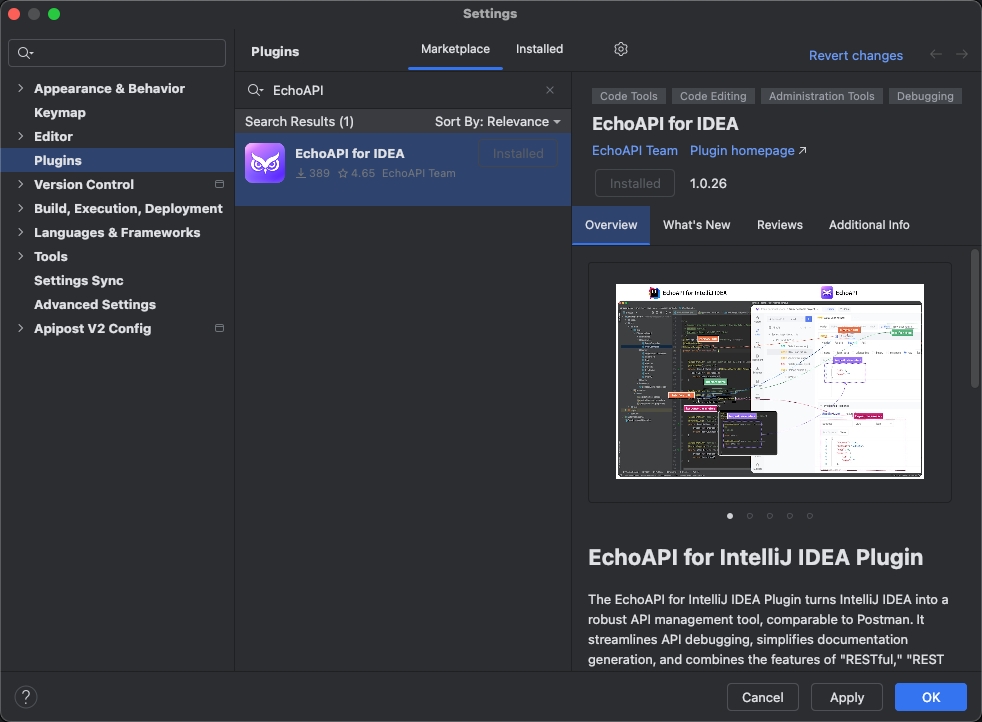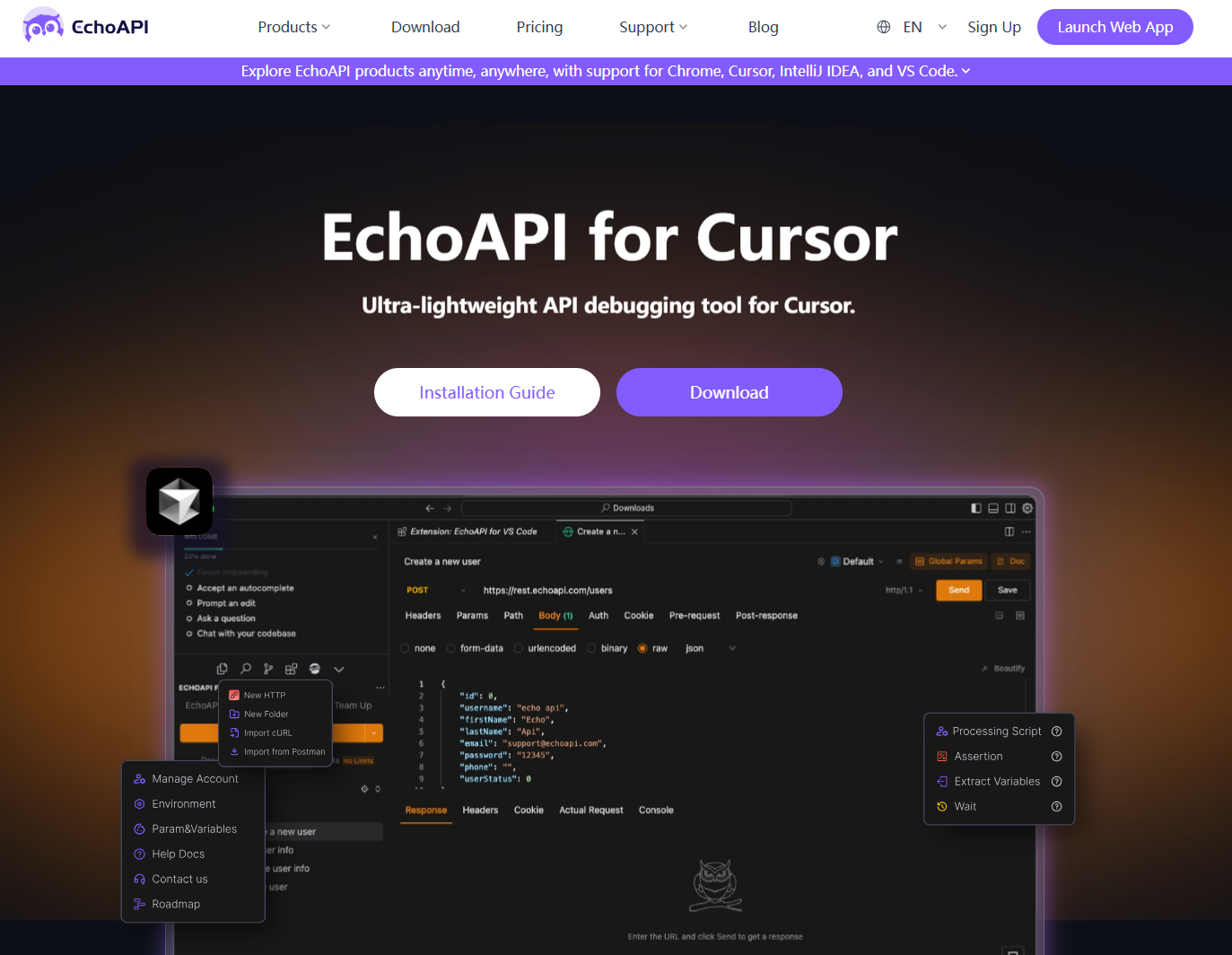Enhancing Frontend and Backend Workflows with EchoAPI
Developers often spend a significant amount of time on API tasks, which involve debugging, writing documentation, automating tests, and performing stress tests. This process usually requires a variety of tools.
Developers often spend a significant amount of time on API tasks, which involve debugging, writing documentation, automating tests, and performing stress tests. This process usually requires a variety of tools. Are you familiar with the following scenarios?
As a frontend developer, you might find yourself worried while waiting for backend interfaces, or you may define mock data using Mock.js and manually set up mock rules. As a backend developer, you often configure tools like Swagger and Postman, and if an interface changes, you have to notify the frontend team one by one. For testers, the situation is similar; you need to define test cases in JMeter based on the interfaces provided by the backend.
When the frontend completes development using the data mocked by Mock.js and the backend finishes development according to the Swagger-defined documentation, both parties may pass their tests. However, when it comes time to integrate, various issues often arise.
Isn't this workflow incredibly complex and tedious? Maintaining data consistency across different tools is not only difficult but also inefficient. The bigger issue is not just the workload; it’s the inconsistency of data between multiple systems. This leads to ineffective collaboration and frequent problems, causing significant frustration for both developers and testers.This is where EchoAPI comes into play.
What is EchoAPI?
EchoAPI is a multifunctional tool for API collaborative development, designed to simplify and accelerate the API development and testing process. Its key features include API documentation, debugging, performance testing, automated testing, mock services, and bulk documentation generation. By addressing data synchronization and communication delays between tools, EchoAPI allows developers to define API documentation once and directly use it for debugging, mocking, and testing, eliminating redundant setups.
With EchoAPI, documentation and debugging are integrated, ensuring that implementations align perfectly with defined documentation. It provides an efficient, timely, and accurate solution within an attractive user interface that supports offline functionality.
EchoAPI easily integrates with various development environments through lightweight plugins for applications like EchoAPI for Cursor, IntelliJ IDEA, VS Code, and Chrome. It also includes Scratch Pad, making it a great alternative to Postman without requiring a login.
EchoAPI Product Matrix
1. EchoAPI Desktop App
The Fastest Way To Debug Your APIs

Advantages of EchoAPI
- No login required and Scratch Pad supported.
- Ultra-lightweight design.
- Fully compatible with Postman’s script syntax.
- Free lightweight plugins for various use cases.
EchoAPI Features
- API Design
- API Debugging
- API Automated Testing
- API Documentation Generation
- API Stress Testing
2. EchoAPI for VSCode
Ultra-lightweight API debugging tool for VS Code.

Advantages of EchoAPI for VSCode:
- Free
- Ultra-lightweight (No app download needed)
- No login required and Scratch Pad supported
- Supports collaboration and manual data bidirectional synchronization
Features:
- API Design
- API Debugging
- API Automated Testing
- API Documentation Generation
3. EchoAPI for IntelliJ IDEA
One-click API documentation, one-click debugging.

Advantages of EchoAPI for IntelliJ IDEA:
- Free
- Ultra-lightweight (No app download needed)
- Unlike Swagger, no code intrusion
- No login required and Scratch Pad supported
- Supports collaboration and manual data bidirectional synchronization
Features:
- API Design
- API Debugging
- API Documentation Generation
4. EchoAPI Interceptor
One-click API capture, one-click debugging.

Advantages of EchoAPI Interceptor
- Free
- Ultra-lightweight (No app download needed)
- No login required and Scratch Pad supported
- Supports collaboration and manual data bidirectional synchronization.
Features:
- API Request Capturing
- Fast Debugging
5.EchoAPI for Cursor
Ultra-lightweight API debugging tool for Cursor.
EchoAPI for Cursor is a plugin that enables the direct development of REST APIs within Cursor. Normally, testing and managing APIs requires switching between multiple tools, but with EchoAPI for Cursor, there is no need for that. This tool integrates code editing and API management functions, providing a fast and smooth workflow.

Advantages of EchoAPI for Cursor
- Mini Lightweight
- Feature-Rich
- Offline Support
- Local Storage
- One-Click Sync
- Free
6. EchoAPI AI
EchoAPI AI is set to launch soon, introducing cutting-edge artificial intelligence to simplify and automate various aspects of API development and testing. Currently, we can use the 'AI Parsing Import' feature to leverage AI technology to interpret API documentation in various formats and quickly import it into EchoAPI.
Note:EchoAPI Product matrix API data synchronization mechanism ensures that no matter what work scenario or tools you use, API data can be synchronized seamlessly.

Innovative Features and User Experience of EchoAPI
- Cross-Platform Plugin Support: Provides multiple free plugins, supports offline use, including EchoAPI for VSCode, EchoAPI Interceptor for Chrome, and EchoAPI for IntelliJ IDEA.
- Multi-Protocol Support: EchoAPI supports not only HTTP but also SSE (Server-Sent Events) and TCP protocols, meeting various API requirements.
- Single API Load Testing: EchoAPI supports quick load testing for APIs without complex configuration processes.
- Advanced Debugging Features: In addition to basic request debugging, supports conditional breakpoints, history tracking, and database linking, significantly increasing debugging efficiency.
- Automated Testing: Built-in powerful API testing framework, supports automated test case creation and execution, ensuring the quality of APIs.
- CI/CD Integration: EchoAPI seamlessly integrates with major CI/CD tools like Jenkins, GitLab CI, and CircleCI, making API testing an integral part of the continuous integration process. Additionally, EchoAPI offers flexible extensibility, supporting custom plugins and scripts to meet special requirements.
- Collaboration and Permissions Management: Supports simultaneous project editing by multiple users and provides detailed permission management to ensure efficient and secure team collaboration.
EchoAPI's Advantages
- No login required and Scratch Pad supported.
- Ultra-lightweight design.
- 100% compatible with Postman script syntax
- Affordable price.
- Free lightweight plugins for various use cases.

Getting Started with EchoAPI
Now that we’ve covered the benefits, let’s dive into how to use EchoAPI to send various requests.
1. Downloading
EchoAPI offers official downloads for Chrome extensions, Windows clients, and macOS clients, with the best option being to download directly from the EchoAPI website. However, I recommend installing the client for greater flexibility.
Download link: EchoAPI Download
2. Installation
Installing the client is straightforward; just follow the on-screen instructions.
3. Simulating Requests (Including File Uploads)
First, let’s create a simple backend API to accept various data.
Next, we’ll begin testing with EchoAPI.
When you first enter EchoAPI, you’ll need to register for an account. After logging in, a pop-up prompt will appear allowing you to create a project. Fill in your project name (choose something meaningful, like "Spring Festival Lucky Money Project"). For this example, we’ll enter "EchoAPI demo".
After creating the project, you can start testing the API.
Here’s a visual to make it clear:

Click "Send," and you will see the response data.
4. Saving and Generating Documentation
Don’t forget to hit "Save!" Once saved, you can view your generated documentation.
5. Team Collaboration
Of course, one of EchoAPI's most powerful features is its team collaboration capability. You won’t have to worry about low development efficiency anymore.
I won’t go into too much detail here, as the interface is user-friendly and self-explanatory.
By integrating EchoAPI into your workflow, you can streamline your development process, enhance productivity, and improve collaboration among your team. Happy coding!
Conclusion
EchoAPI has completely transformed the way developers manage APIs. Its powerful features and user-friendly design allow developers to focus on coding without being constrained by the tools they use. The variety of plugins available caters to the needs of different team members.
For complex enterprise-level projects, EchoAPI is undoubtedly a fantastic choice. Whether it’s multi-protocol support, comprehensive API management, advanced debugging capabilities, or automated testing and collaboration, EchoAPI demonstrates exceptional performance and user experience.
If you're looking for an API management tool that can handle complex requirements, give EchoAPI a try. I hope this article helps you make an informed decision and leads your team to a more efficient and enjoyable development experience.




 EchoAPI for VS Code
EchoAPI for VS Code

 EchoAPI for IntelliJ IDEA
EchoAPI for IntelliJ IDEA

 EchoAPl-Interceptor
EchoAPl-Interceptor

 EchoAPl CLI
EchoAPl CLI
 EchoAPI Client
EchoAPI Client API Design
API Design
 API Debug
API Debug
 API Documentation
API Documentation
 Mock Server
Mock Server








